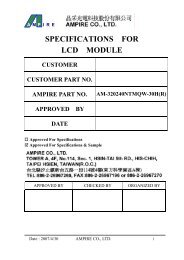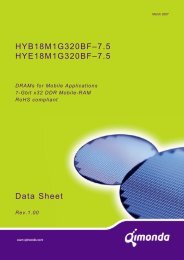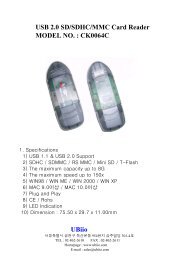You also want an ePaper? Increase the reach of your titles
YUMPU automatically turns print PDFs into web optimized ePapers that Google loves.
Internet Data Sheet<br />
HY[B/I]18T256[40/80/16]0B[C/F](L)<br />
256-Mbit Double-Data-Rate-Two SDRAM<br />
34) For these parameters, the DDR2 SDRAM device is characterized and verified to support t nPARAM = RU{t PARAM / t CK.AVG }, which is in clock<br />
cycles, assuming all input clock jitter specifications are satisfied. For example, the device will support t nRP = RU{t RP / t CK.AVG }, which is in<br />
clock cycles, if all input clock jitter specifications are met. This means: For DDR2–667 5–5–5, of which t RP = 15 ns, the device will support<br />
t nRP = RU{t RP / t CK.AVG } = 5, i.e. as long as the input clock jitter specifications are met, Precharge command at Tm and Active command at<br />
Tm + 5 is valid even if (Tm + 5 - Tm) is less than 15 ns due to input clock jitter.<br />
35) t WTR is at lease two clocks (2 x t CK ) independent of operation frequency.<br />
TABLE 53<br />
DRAM Component Timing Parameter by Speed Grade - DDR2–667<br />
Parameter Symbol DDR2–667 Unit Notes 1)2)3)4)5)6)<br />
DQ output access time from CK / CK t AC –450 +450 ps<br />
CAS to CAS command delay t CCD 2 — nCK<br />
Average clock high pulse width t CH.AVG 0.48 0.52 t CK.AVG<br />
9)10)<br />
Average clock period t CK.AVG 3000 8000 ps<br />
CKE minimum pulse width ( high and low pulse t CKE 3 — nCK<br />
11)<br />
width)<br />
Average clock low pulse width t CL.AVG 0.48 0.52 t CK.AVG<br />
9)10)<br />
Auto-Precharge write recovery + precharge time t DAL WR + t nRP — nCK<br />
12)13)<br />
Minimum time clocks remain ON after CKE<br />
asynchronously drops LOW<br />
Min.<br />
Max.<br />
t DELAY t IS + t CK .AVG +<br />
t IH<br />
–– ns<br />
DQ and DM input hold time t DH.BASE 175 –– ps<br />
7)<br />
8)<br />
18)19)14)<br />
DQ and DM input pulse width for each input t DIPW 0.35 — t CK.AVG<br />
DQS output access time from CK / CK t DQSCK –400 +400 ps<br />
8)<br />
DQS input high pulse width t DQSH 0.35 — t CK.AVG<br />
DQS input low pulse width t DQSL 0.35 — t CK.AVG<br />
DQS-DQ skew for DQS & associated DQ signals t DQSQ — 240 ps<br />
15)<br />
DQS latching rising transition to associated clock<br />
edges<br />
t DQSS – 0.25 + 0.25 t CK.AVG<br />
16)<br />
DQ and DM input setup time t DS.BASE 100 –– ps<br />
17)18)19)<br />
DQS falling edge hold time from CK t DSH 0.2 — t CK.AVG<br />
16)<br />
DQS falling edge to CK setup time t DSS 0.2 — t CK.AVG<br />
16)<br />
CK half pulse width t HP Min(t CH.ABS ,<br />
t CL.ABS )<br />
__ ps<br />
20)<br />
Data-out high-impedance time from CK / CK t HZ — t AC.MAX ps<br />
Address and control input hold time t IH.BASE 275 — ps<br />
24)22)<br />
Control & address input pulse width for each input t IPW 0.6 — t CK.AVG<br />
Address and control input setup time t IS.BASE 200 — ps<br />
DQ low impedance time from CK/CK t LZ.DQ 2xt AC.MIN t AC.MAX ps<br />
8)21)<br />
DQS/DQS low-impedance time from CK / CK t LZ.DQS t AC.MIN t AC.MAX ps<br />
8)21)<br />
MRS command to ODT update delay t MOD 0 12 ns<br />
Mode register set command cycle time t MRD 2 — nCK<br />
OCD drive mode output delay t OIT 0 12 ns<br />
34)<br />
DQ/DQS output hold time from DQS t QH t HP – t QHS — ps<br />
25)<br />
8)21)<br />
23)24)<br />
34)<br />
<strong>Rev</strong>. <strong>1.11</strong>, 2007-07 49<br />
11172006-LBIU-F1TN



![Internet Data Sheet HYB18TC256[80/16]0BF Rev. 1.3 - UBiio](https://img.yumpu.com/50510226/1/184x260/internet-data-sheet-hyb18tc25680-160bf-rev-13-ubiio.jpg?quality=85)
![Internet Data Sheet HYS72T[32/64]xxxHP-[3S/3.7]-A Rev. 1.01 - UBiio](https://img.yumpu.com/50510224/1/184x260/internet-data-sheet-hys72t32-64xxxhp-3s-37-a-rev-101-ubiio.jpg?quality=85)

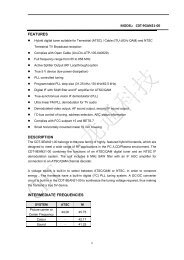
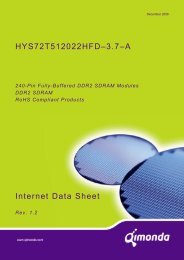

![Internet Data Sheet HY[B/I]39SC128[800/160]FE Rev. 1.1 - UBiio](https://img.yumpu.com/31629373/1/184x260/internet-data-sheet-hyb-i39sc128800-160fe-rev-11-ubiio.jpg?quality=85)
